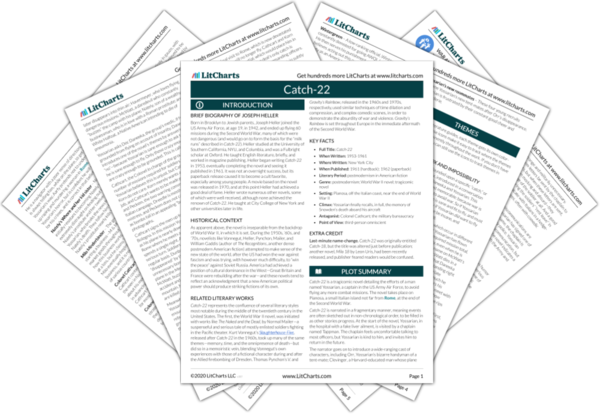Summary
Analysis
Hungry Joe, the soldier tormented by nightmares, lives in a tent with Huple, who is fifteen and lied about his age to enter the Army. Hungry Joe has flown 50 missions and waits with his bags packed, but is not permitted by Cathcart to return home. Joe commands Huple to wrap his ticking watch in wool socks and dampen all other sounds in the tent; any sudden noise scares Joe and causes him to scream.
Joe’s “shell shock” is so pronounced that he cannot stand sudden sounds or movements of any kind. Huple must bear the brunt of his fears, although many soldiers throughout the Pianosa encampment are distracted by Hungry Joe’s loud nightmares.
Themes
Before the war, Joe was a photographer for Life magazine. He often tries to take compromising pictures of visiting women around the base, but the pictures “don’t turn out”—the lens-cap is still on, or the camera otherwise malfunctions. Joe becomes crazed in the presence of women, so much so that he doesn’t know whether to “furgle them or photograph them.” He seldom manages to do either.
In addition to his traumatic nightmares, Joe has a “voyeuristic” impulse, meaning he likes to photograph other people, often in sexually-compromising poses. Although Joe enjoys this very much, he gets so excited he can never take the pictures. This is in comparison to Aarfy’s pronounced (and actual) mistreatment of women.
Themes
Hungry Joe’s nightmares stop temporarily when he ceases waiting to return home—that is, when Cathcart again raises the number of required missions. Joe has met Cathcart’s requirements six times, but Cathcart has subsequently raised the mission-total each time. Joe denies that his nightmares are serious, saying “everyone has nightmares,” but his fellow soldiers are alarmed by his screams.
The only thing that gives Hungry Joe any pause is the notion that he now has to fly. This implies that the flying itself is not the problem; rather, it is the hope that maybe he can escape the war that makes the flying so terrifying—the possibility of death in each mission becomes more terrible when an end to those missions is in sight.
Themes
Yossarian recalls a flight over Ferrara, some time before, when he took his planes (six in total) over the target, a bridge, two separate times. This second trip, necessary to destroy the bridge, was especially dangerous, and resulted in the death of Kraft, a young and eager soldier from Pennsylvania.
An instance of Yossarian’s “bravery.” But this bravery has a terrible, if unintended, consequence. Perhaps if Yossarian had acted out of cowardice and avoided the second pass over Ferrara, Kraft would still be alive.
Themes
Get the entire Catch-22 LitChart as a printable PDF.

The narrator abruptly transitions to a story of a Ping-Pong match between Appleby (the group’s best player) and Orr. Orr becomes so enraged with Appleby, who is winning handily, that he smashes him in the face with his paddle. An enormous fight breaks out, and Chief White Halfoat accidentally punches Moodus, Dreedle’s loathed assistant and son-in-law, in the face.
One of a few large fights that break out from time to time on Pianosa. It seems that a certain amount of the aggression of combat bleeds into the interactions between the soldiers. In many of these fights, Moodus or Nately are the soldiers who get injured first.
Themes
Chief White Halfoat is playing a practical joke on his tent-mate, Flume, whispering to him that he, Halfoat, will eventually slit Flume’s throat as he sleeps. This makes it impossible for Flume to get a real night’s rest. Halfoat himself desires to sleep but can’t, on account of Hungry Joe’s screaming nightmares.
It does not appear that Halfoat will follow through on his promise, but Flume is unwilling to take any chances. Halfoat enjoys joking with a white man, as payback for the white oppressors of his past.
Themes
Yossarian asks Wintergreen, a subordinate of Cathcart’s, how Cathcart can assign more mandatory missions (55, at time point) than the 27th Squadron requires (only 40). Wintergreen answers that Catch-22 is to blame. Yossarian must obey all orders—whatever Cathcart commands—regardless of what Cathcart himself is commanded. Yossarian, who has 48 missions, is stuck—he has been bested by Cathcart once again.
This Catch-22 of Wintergreen’s is a little less clear-cut than Daneeka’s initial example. But it is a logical bind nonetheless. Yossarian has to follow all orders, even when those orders change. In reality, he must follow the whims of his superior officers—and when those whims change, Yossarian still must obey the most recent order. Meanwhile, those who give the orders will never admit that they have changed based on a whim or mistake.
Themes












